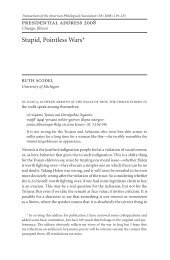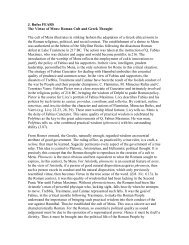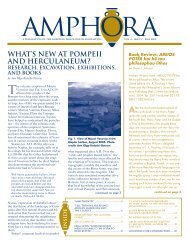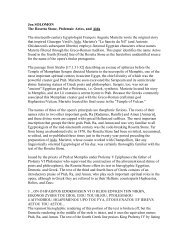classics rewritten in stone: the art of anita huffington - American ...
classics rewritten in stone: the art of anita huffington - American ...
classics rewritten in stone: the art of anita huffington - American ...
Create successful ePaper yourself
Turn your PDF publications into a flip-book with our unique Google optimized e-Paper software.
2<br />
THE ROMANS IN GAUL TODAY: LIVING<br />
HISTORY AND EXPERIMENTAL ARCHAEOLOGY<br />
IN THE RHÔNE-ALPES REGION OF FRANCE<br />
by Timothy Wutrich<br />
L iv<strong>in</strong>g<br />
history is <strong>the</strong> process whereby<br />
history enthusiasts research a period,<br />
design and build costumes and<br />
sometimes weapons and implements <strong>of</strong><br />
daily life, and create personae <strong>in</strong> order to<br />
reenact events from <strong>the</strong> past, <strong>of</strong>ten at<br />
historically significant sites. The people<br />
and events that one reads about <strong>in</strong> books<br />
and hears about <strong>in</strong> school become real<br />
when one visits an historical site where<br />
costumed museum staff reenact life <strong>in</strong><br />
ano<strong>the</strong>r era. But can liv<strong>in</strong>g history go<br />
beyond parad<strong>in</strong>g costumes and help us to<br />
understand <strong>the</strong> people and customs,<br />
even <strong>the</strong> movement and behavior <strong>of</strong> life<br />
<strong>in</strong> ancient times? Is <strong>the</strong>re, <strong>in</strong> fact, a connection<br />
between liv<strong>in</strong>g history and<br />
experimental archaeology?<br />
Experimental archaeology may be<br />
seen as a way <strong>of</strong> look<strong>in</strong>g at historical or<br />
archaeological problems that moves<br />
beyond <strong>the</strong> library or <strong>the</strong> dig. It applies<br />
trial-and-error methods to problems<br />
from <strong>the</strong> past that cannot be answered<br />
only by library research or by <strong>art</strong>ifacts <strong>in</strong><br />
a museum or at an archaeological site.<br />
But experimental archaeology is not <strong>the</strong><br />
same as liv<strong>in</strong>g history. Even though<br />
liv<strong>in</strong>g history and experimental archaeology<br />
may be two different th<strong>in</strong>gs, <strong>the</strong><br />
heuristic methods – (<strong>the</strong> experimental<br />
trial and error techniques) – employed<br />
by both enterprises never<strong>the</strong>less connect<br />
<strong>the</strong>m. Through attempts to recreate<br />
antiquity, liv<strong>in</strong>g history approaches<br />
experimental archaeology. François<br />
Gilbert is <strong>the</strong> founder and president <strong>of</strong><br />
Pax Augusta (http://www.paxaugusta<br />
.net), a reenactment group based near<br />
Lyon, France, that recreates Roman<br />
military and civilian life dur<strong>in</strong>g <strong>the</strong> reign<br />
<strong>of</strong> Augustus. Gilbert, author <strong>of</strong> five<br />
books and numerous <strong>art</strong>icles on subjects<br />
rang<strong>in</strong>g from <strong>the</strong> Roman Army to<br />
Roman women, remarks that experimental<br />
archaeology means more than<br />
parad<strong>in</strong>g <strong>in</strong> historical costume. The<br />
parade, <strong>in</strong> effect, is <strong>the</strong> presentation <strong>of</strong><br />
<strong>the</strong> research.<br />
At present, numerous North<br />
<strong>American</strong> and European reenactment<br />
groups dedicate <strong>the</strong>mselves to reconstruct<strong>in</strong>g<br />
ancient Roman military and<br />
civilian life. Mat<strong>the</strong>w Amt, an <strong>American</strong><br />
reenactor <strong>in</strong> <strong>the</strong> Wash<strong>in</strong>gton, D.C. area<br />
who founded Legio XX, lists on his<br />
website about fifty-two active groups <strong>in</strong><br />
<strong>the</strong> United States and Canada and about<br />
sixty groups <strong>in</strong> Europe and Russia<br />
(http:// www.larp.com/legioxx/<strong>in</strong>dex<br />
.html). A number <strong>of</strong> reenactors <strong>in</strong> America<br />
and <strong>in</strong> Europe have relied on Amt’s<br />
research as <strong>the</strong>y formed <strong>the</strong>ir own liv<strong>in</strong>g<br />
history groups. They regard Amt as an<br />
authority on historical reenactment,<br />
prais<strong>in</strong>g <strong>the</strong> Legio XX website as one <strong>of</strong><br />
<strong>the</strong> best. When asked to consider those<br />
who have <strong>in</strong>fluenced his work on Roman<br />
reenactment, Amt refers to an <strong>American</strong><br />
Revolutionary War reenactment group<br />
to which he belonged, stress<strong>in</strong>g that<br />
group’s dedication to au<strong>the</strong>nticity <strong>in</strong> creat<strong>in</strong>g<br />
costumes and weapons; he also<br />
acknowledges <strong>the</strong> book The Roman<br />
Legions Recreated <strong>in</strong> Colour Photographs by<br />
Daniel Peterson (Crowood 1999), as well<br />
as <strong>the</strong> historical scholarship <strong>of</strong> J.E.<br />
Lendon <strong>in</strong> Soldiers and Ghosts: A History<br />
<strong>of</strong> Battle <strong>in</strong> Classical Antiquity (Yale 2005).<br />
The Erm<strong>in</strong>e Street Guard (http://www<br />
.erm<strong>in</strong>estreetguard .co.uk/), an English<br />
reenactment group founded <strong>in</strong> 1972, also<br />
receives praise from reenactors such as<br />
Amt because <strong>of</strong> its high standards <strong>of</strong><br />
au<strong>the</strong>nticity.<br />
F<strong>in</strong>d<strong>in</strong>g a reenactment <strong>in</strong> North<br />
America, however, is not always easy.<br />
The North <strong>American</strong> groups are<br />
scattered widely across <strong>the</strong> cont<strong>in</strong>ent.<br />
One can, <strong>of</strong> course, see reenactments <strong>of</strong><br />
Roman military and civilian life <strong>in</strong> recent<br />
popular films based on ancient history<br />
such as Gladiator. One can f<strong>in</strong>d reenactments<br />
<strong>of</strong> <strong>the</strong> Roman world on PBS and<br />
<strong>the</strong> History Channel. But <strong>the</strong> obvious<br />
major impediment to reenactment <strong>of</strong><br />
ancient Roman life <strong>in</strong> North America is<br />
location. North <strong>American</strong> reenactors face<br />
a clear disadvantage compared to <strong>the</strong>ir<br />
European counterp<strong>art</strong>s, for not only<br />
must <strong>the</strong> <strong>American</strong>s recreate costumes,<br />
weapons, and <strong>the</strong> implements <strong>of</strong> Roman<br />
daily life, but <strong>the</strong>y must also recreate <strong>the</strong><br />
historical space, s<strong>in</strong>ce <strong>the</strong>re are no<br />
ancient Roman sites <strong>in</strong> North America.<br />
European reenactors have <strong>the</strong> advantage<br />
<strong>of</strong> recreat<strong>in</strong>g history at places where<br />
Roman history actually occurred. Therefore,<br />
it is much easier to be aware <strong>of</strong> <strong>the</strong><br />
Romans <strong>in</strong> Gaul, that is, France, where<br />
<strong>the</strong> Roman presence has been felt for<br />
over two millennia.<br />
Of <strong>the</strong> many Roman ru<strong>in</strong>s throughout<br />
France, <strong>the</strong> Rhône-Alpes region <strong>in</strong><br />
p<strong>art</strong>icular has many outstand<strong>in</strong>g sites.<br />
Aix-les-Ba<strong>in</strong>s has <strong>the</strong> funeral arch <strong>of</strong><br />
Lucius Pompeius Campanus, a patrician<br />
from Gallia Narbonensis, and <strong>the</strong><br />
second-best surviv<strong>in</strong>g Roman temple on<br />
French soil, <strong>the</strong> so-called Temple <strong>of</strong><br />
Fig. 2. The Italian reenactment group Legio XXX Ulpia Traiana Victrix brought<br />
this functional scorpio, an ancient siege weapon that fires arrows, to <strong>the</strong> Gallo-<br />
Roman days <strong>in</strong> Sa<strong>in</strong>t-Roma<strong>in</strong>-en-Gal (Isère, France) <strong>in</strong> June 2006.


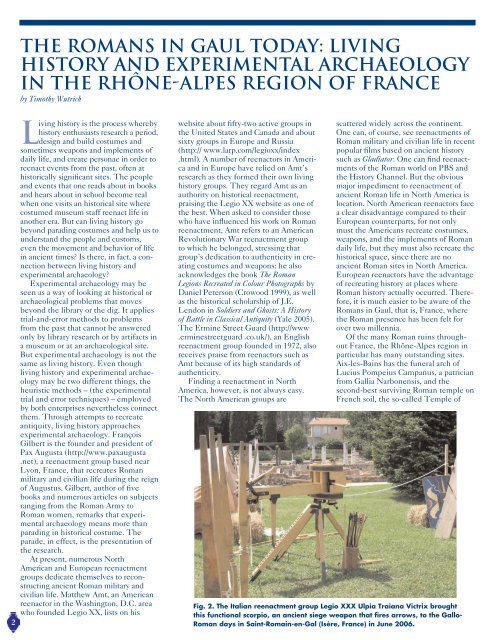
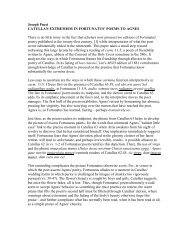
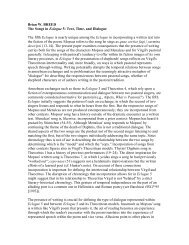
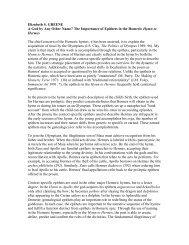

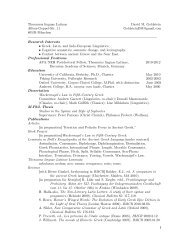
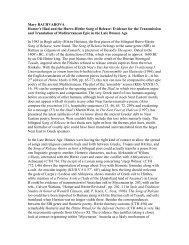

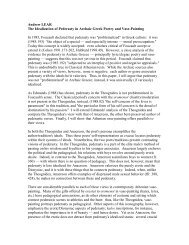
![John H. STARKS, Jr. [vo]cales vultus:Pantomime Actresses in Latin ...](https://img.yumpu.com/11930335/1/190x245/john-h-starks-jr-vocales-vultuspantomime-actresses-in-latin-.jpg?quality=85)
